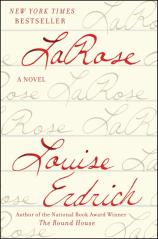Reading Group Guide
Discussion Questions
LaRose

1. What are the intended effects of Emmaline and Landreaux’s traditional act of giving LaRose to the Raviches? In what ways does it achieve these or not? What are the costs?
2. What is the nature of the two marriages at the center of the novel, the Irons and the Raviches? How are they similar or different?
3. Consider the first LaRose. What were her particular strengths? What was essential to her ability to survive the neglect and abuse from her mother Mink, Mackinnon and the mission school?
4. In what ways does Wolfred help and balance LaRose before and throughout their marriage?
5. What common qualities does each LaRose possess?
6. When Nola accepts LaRose from the Irons, she’s not sure if she does so for the profound beauty of the gesture or because it will so deeply punish them. Is she obligated to respond in any particular way to such a gesture?
7. Revenge is sought by various characters throughout the novel: Maggie’s defense of LaRose, LaRose’s fighting the Fearsome Four, Romeo’s longstanding behavior toward Landreaux. What is revenge? What is it intended to accomplish? In what ways does it help or harm? Is it, as Romeo believes, a form of justice?
8. Mrs. Peace, the fourth LaRose and Emmaline’s mother, abstains from any romantic relationships after her “cruel, self-loving, and clever” husband, Billy Peace, dies, saying that, “he had taught her what she needed to know about men.” What does she mean? Where in the novel is a man able to show kindness or selflessness?
9. Consider the girls in both families: The “Iron Maidens,” Snow and Josette, and Maggie Ravich. What is each like? What are their particular strengths? What do they provide for each other?
10. How does each person in the novel respond to such profound grief and loss? Which response seems the healthiest?
11. What’s the relationship between suffering and anger in the novel? What is the value of anger? What’s the healthiest response to it?
12. What does Father Travis provide all involved with the loss of Dusty? What are his own struggles? How do they affect his ability to help his community?
13. What’s the nature of technology as it’s presented in Peter Ravich’s concern about Y2K and Snow and Josette’s obsession with “robot/cyborg” movies?
14. How do the Irons work to balance a connection with their traditional wisdom and rituals with a rapidly changing modern world?
15. At one point Randall explains that the medicine his people did in the past was not magic, but “beyond ordinary understanding now.” What does he mean? Why is it important to not see such healing as magic?
16. Consider the image of cake as it appears throughout the novel. What are its various connotations? How is this complicated by Nola’s obsessive making of cakes or Peter’s concern about the eating of sugar?
17. How does Nola’s deep, suicidal depression affect the members of her family? What aids in her healing?
18. Mrs. Peace, thinking about Frank Baum’s genocidal policy and all the cultural loss and destruction it caused, says the resulting loneliness “sets deep in a person,” and takes four generations to heal. Why might it take this long? What is it about the fourth LaRose that suggests the nature of such healing?
19. To what extent is some kind of disconnection necessary to survive such cultural and personal tragedy? What are the various ways characters disconnect throughout the novel? Where are key moments of reconnection?
20. To what extent is Romeo’s vengeful and self-destructive behavior understandable given his past? In addition to his physical injury, what were important moments of harm or loss? What helps explain his improvement over time?
21. When Landreaux suggests escaping from the boarding school, Romeo sees in his eyes an “opacity of spirit.” What does this mean? Where else do people struggle with such a thing in the novel?
22. Romeo considers the strong painkillers he takes as “the only mercy in this world.” How do other characters use drugs or alcohol? When is it necessary or valuable, when is it unhealthy?
23. Romeo, revealing his often hidden or overlooked intelligence, tries to explain to Hollis about “intergenerational trauma.” What is this? What is necessary for it to be healed?
24. In the kitchen with his mother and sisters, LaRose says “what we used for TV in the olden times was stories.” What is the importance of storytelling in a family or culture? How has modern TV and media changed the nature and content of stories? What are the effects of this?
25. Throwing their dandelion forks into the woods, LaRose says to Maggie, “Let’s stop being grown-ups.” In what ways have the children in each family demonstrated maturity and understanding to compensate for the adults? What might explain such strength and insight in young people?
26. At Hollis’ graduation party, many of the people “spoke in both languages” as they enjoyed cake. In addition to language, what are the best ways to stay connected to valuable traditions?
LaRose
- Publication Date: May 10, 2016
- Genres: Fiction
- Hardcover: 384 pages
- Publisher: Harper
- ISBN-10: 0062277022
- ISBN-13: 9780062277022








